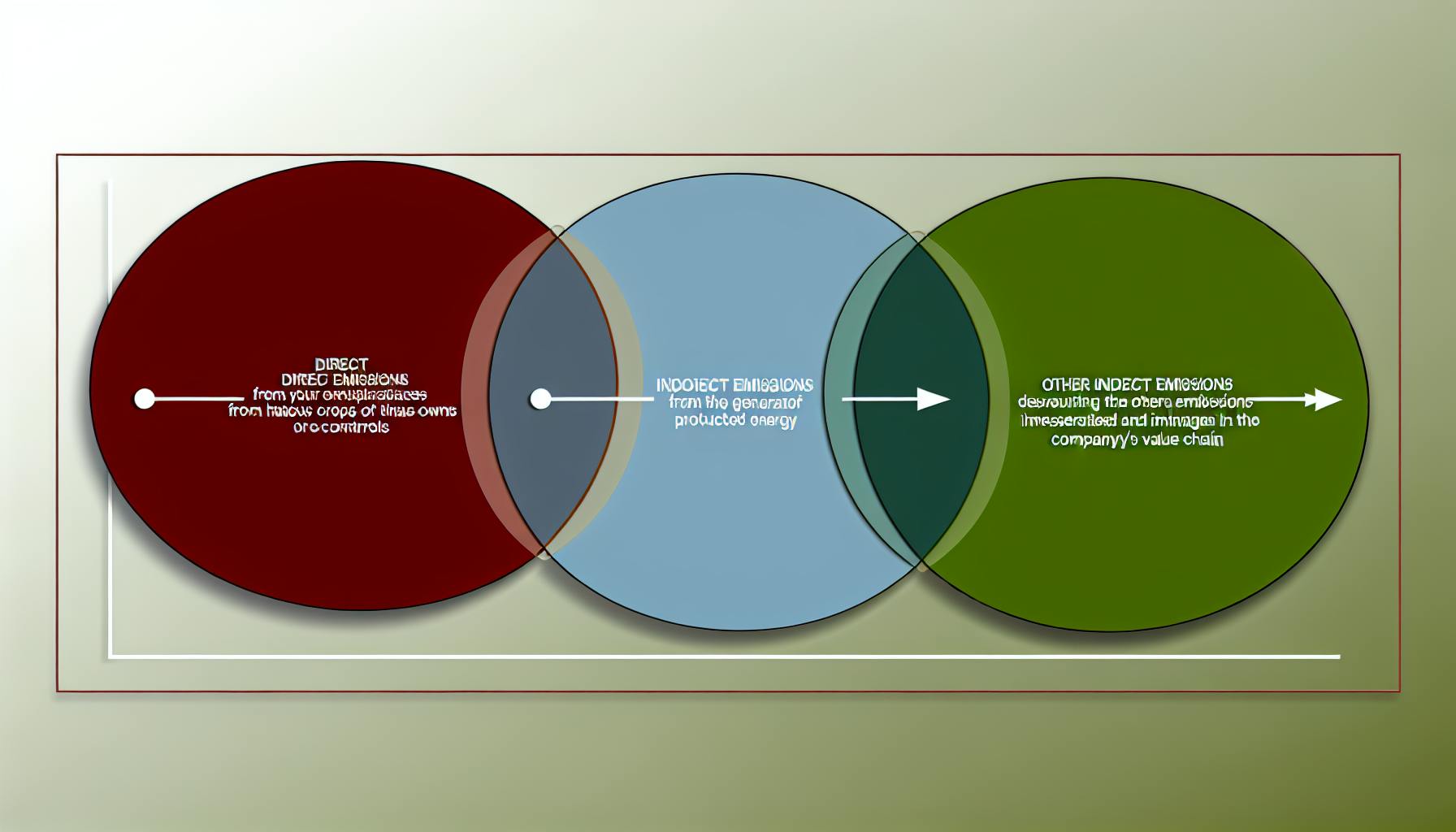With climate change being a growing concern, businesses want to understand their carbon footprint.
This article will demystify carbon accounting platforms - explaining the key features, benefits, and how to choose the right one for your organization's sustainability needs.
You'll learn the fundamentals of these platforms, from core functions to market landscape, and get actionable advice on selection criteria, software options, integration, and more.
Unpacking the Essentials of Carbon Accounting Platforms
Carbon accounting platforms provide businesses with the tools to measure, report on, and reduce their greenhouse gas (GHG) emissions. As climate change continues to pose an existential threat, these platforms empower companies to understand, take ownership of, and mitigate their environmental impact.
Demystifying Carbon Accounting Platforms for SMEs
Carbon accounting software tracks a company's carbon footprint across direct emissions from owned or controlled sources (Scope 1), indirect emissions from the generation of purchased electricity, steam, heating and cooling (Scope 2), and all other indirect emissions that occur in the value chain (Scope 3). By consolidating energy and emissions data from across the organization into a single platform, companies gain visibility into the largest contributors to their environmental footprint.
Leading carbon accounting platforms are designed specifically for small-to-medium enterprises (SMEs). They remove the complexity of carbon accounting and provide an intuitive interface to view analytics on emission sources, track performance over time, model future reduction plans, and generate comprehensive reports for both internal tracking and external disclosure.
Exploring the Advantages of Carbon Accounting for Businesses
Adopting a carbon accounting platform yields multiple benefits for SMEs:
- Compliance - Prepare for emerging regulations requiring climate-related financial disclosures by having emissions data readily available.
- Efficiency - Identify the most impactful areas to drive energy efficiency with data-backed insights.
- Cost Savings - Reduce operating expenses by cutting energy waste and associated carbon emissions.
- Reputation - Meet stakeholder expectations around sustainability commitments and actions.
Evaluating the Core Functions of Carbon Accounting Platforms
The core functionality provided by carbon accounting platforms includes:
- Data consolidation - Ingest data from utility bills, fleet vehicles, travel, procurement records, and other sources.
- Emissions calculation - Leverage localized emissions factors to automatically calculate overall carbon footprint.
- Visualization - Gain visibility into emissions breakdown across the value chain through interactive charts and graphs.
- Target setting - Define science-based emission reduction targets in line with 1.5°C climate scenarios.
- Reporting - Build reports tailored to key stakeholders like leadership, investors, and customers.
Navigating the Carbon Accounting Software Market
The market for carbon accounting software continues to grow rapidly as stakeholder demands for corporate climate responsibility accelerate. While bespoke consulting solutions exist, purpose-built software designed for SMEs offers an affordable path to baseline emissions understanding and ongoing tracking.
As the effects of climate change intensify, carbon accounting platforms provide companies with the foundational insights required to decarbonize their operations and supply chain. Their adoption will soon transition from a competitive advantage to cost of doing business across nearly every industry.
What is a carbon accounting software?
Carbon accounting software provides businesses with a specialized platform to calculate, analyze, and report on their greenhouse gas (GHG) emissions and overall carbon footprint. As concerns around climate change grow, these tools help companies track and manage their environmental impact to set and meet sustainability goals.
The core functionality of carbon accounting platforms includes:
- Calculating emissions across all scopes and categories based on business operational data
- Modeling future emissions projections based on reduction targets
- Generating visual reports on emissions data for internal tracking and external disclosures
- Providing dashboards to view emissions performance over time
- Helping companies identify hotspots and opportunities to lower emissions
- Ensuring accurate carbon accounting as per leading reporting protocols
By leveraging [[carbon accounting software|carbon accounting platforms]], organizations can simplify the complex process of carbon reporting and turn their emissions data into actionable insights. The right solution empowers companies to make progress on their net zero commitments and effectively communicate their sustainability stories.
What are the methods of carbon accounting?
Carbon accounting calculates an organization's greenhouse gas (GHG) emissions using two main methodologies:
Spend-based
The spend-based methodology uses financial expenditure data across various categories like energy, transportation, materials, etc. to estimate emissions. This top-down approach applies emissions factors to spending data to determine a company's carbon footprint.
Benefits:
- Quick and easy to implement
- Leverages existing financial reporting
Limitations:
- Less accurate
- Limited insights for reducing emissions
Activity-based
The activity-based methodology is a bottom-up approach that calculates emissions based on detailed data of organizational activities and processes that produce GHGs. This provides greater accuracy but requires more effort to collect granular data.
Benefits:
- More accurate carbon accounting
- Actionable insights for emission reductions
Limitations:
- More resource intensive
Hybrid
Some carbon accounting platforms combine both methodologies to balance accuracy and ease of use. The hybrid methodology applies the detailed activity-based approach to high-impact areas, while using the more efficient spend-based method for lower-impact activities.
Choosing the right methodology depends on your business needs, resources, and goals for sustainability reporting. As reducing emissions becomes more vital for organizations, shifting towards activity-based or hybrid methods can provide better insights to guide climate action strategies.
What is the world's most widely used carbon accounting method?
The GHG Protocol developed by the World Resources Institute (WRI) and the World Business Council for Sustainable Development (WBCSD) provides the most widely adopted global greenhouse gas accounting standards.
Specifically, the GHG Protocol Corporate Accounting and Reporting Standard serves as the basis for the majority of corporate carbon accounting and reporting programs globally. Some key features of this standard include:
- Covers the accounting and reporting of 7 greenhouse gases
- Defines direct and indirect emissions across Scopes 1, 2, and 3
- Outlines requirements for tracking emission sources, setting organizational boundaries, managing data quality, and more
- Provides flexibility to accommodate varying business contexts while enabling consistent measurement across companies
Since the GHG Protocol was first released in 2001, it has been integrated into numerous carbon regulations and frameworks internationally. Over 90% of Fortune 500 companies that report on sustainability utilize the GHG Protocol corporate standard.
Its widespread adoption makes the GHG Protocol the de facto carbon accounting platform for enabling consistent and credible corporate carbon reporting worldwide. Companies leveraging automated solutions like carbon accounting software should ensure alignment with the GHG Protocol methodology.
sbb-itb-0f1f828
What companies do carbon accounting?
Many companies are realizing the importance of measuring and reducing their carbon footprint. Carbon accounting software startups and platforms are emerging to help organizations track, analyze, and report emissions data.
Some key players in the carbon accounting software space include:
- Persefoni: Offers a SaaS platform to calculate, analyze and report on carbon footprints based on greenhouse gas protocol standards. Helps companies establish reduction targets and create low-carbon transition plans.
- SINAI Technologies: Provides an automated carbon accounting and reporting solution catered to small and medium enterprises. Syncs data from various business tools to generate comprehensive emissions reports.
- Watershed: A complete carbon accounting and inventory platform designed for enterprises. Automates data collection and provides detailed analytics on scope 1, 2 and 3 emissions.
- Carbon Analytics: Focuses on product carbon footprinting and hotspot analysis. The software integrates with ERP and PLM systems to deliver granular insights on emissions from materials, transportation and manufacturing.
The need for robust carbon accounting platforms is being driven by evolving climate regulations, investor pressures and rising stakeholder expectations on ESG performance. An accurate understanding of emissions is the first step for organizations aiming to achieve net-zero carbon targets over the next few decades.
Selecting the Best Carbon Accounting Platform for Your Business
As businesses work to reduce their environmental impact, implementing an effective carbon accounting platform is key. However, with many options now available, selecting the right software can be a challenge. This section provides guidance on choosing a solution tailored to your organization's unique sustainability objectives and business needs.
Understanding the Criteria for Platform Selection
When evaluating carbon accounting platforms, some of the essential criteria to consider include:
- Scalability: Can the software scale with your business as it grows in size and complexity over time? Seek out versatile platforms built to handle evolving sustainability needs.
- Accuracy: How precise and reliable are the emissions calculations? Higher data quality and internationally-recognized standards like GHG Protocol indicate more robust methodologies.
- User-Friendliness: Intuitive, easy-to-use interfaces reduce staff learning curves. Seek platforms with customizable dashboards, automated data imports, and clear visualization tools.
- Cost-Effectiveness: Balancing functionality with affordability is key, especially for small-medium enterprises. Consider free trials to test capabilities.
Assessing the Carbon Accounting Software Free and Paid Options
Free carbon accounting tools provide basic capabilities but often lack advanced analytics. Paid platforms offer enhanced customization, benchmarks, consulting support, and integration capabilities justifying ROI.
Conduct trials first to determine if basic free solutions meet needs or more sophisticated paid versions are worthwhile given sustainability objectives.
The Emergence of Carbon Accounting Startups
Exciting startups are accelerating carbon accounting innovation. Leveraging cloud computing they provide affordable, automated solutions to help companies track emissions faster.
By specializing in sustainability, they often understand nuances facing different industries better. Evaluating offerings from both startups and established providers is worthwhile.
Comparing Top Carbon Accounting Software: Persefoni and Others
Persefoni shines with an easy-to-use interface, industry-leading accuracy certifications, and excellent customer support. Integration with business intelligence tools like Tableau also makes analyzing emissions easy.
However, exploring diverse options across startups and established vendors allows determining the best fit. From supply chain analytics to goal setting and progress tracking, priority feature requirements differ. Multiple trials may be needed to make the right carbon accounting software choice.
Integration and Adoption: Making the Most of Your Carbon Accounting Platform
Adopting a carbon accounting platform can significantly streamline sustainability reporting and provide actionable insights to reduce your emissions footprint. However, to realize the full benefits, thoughtful integration with your existing systems and workflows is key. This section offers practical guidance on making the most of your investment in carbon accounting software.
Building an Effective Carbon Accounting Ecosystem
When implementing a new carbon accounting platform, take time upfront to map out data connections to other business systems like ERPs, utility billing, fleet telematics etc. Setting up automated data imports reduces manual effort and minimizes errors that creep in via manual data entry.
Equally important is integrating sustainability data into planning and decision cycles across the organization. Connect emissions analytics to budgeting processes, procurement policy, supply chain design and so on to make carbon accounting an integral part of business operations rather than an isolated reporting activity.
Employee Engagement and Platform Training
The success of a carbon accounting platform relies heavily on employee adoption. Conduct training workshops to educate staff on sustainability best practices and demonstrate practical usage of the software's features. Short videos can reinforce learning for new joiners.
Involve teams in target-setting, ideation challenges and hackathons focused on carbon reduction. Recognition programs that showcase teams demonstrating innovative ways to leverage the carbon accounting platform build greater engagement.
Continuous Improvement: Analyzing and Acting on Data
While robust emissions measurement is the foundation, the ultimate goal is driving actual reductions. Set up regular reviews of carbon accounting data - both at an overall organizational and department/site level. Identity hotspots for reduction initiatives based on emission trends.
As reduction projects get implemented, continue monitoring emissions data to quantify results and ensure progress stays on track. The regular rhythm of goal-setting, execution and performance reviews, backed by accurate data, enables continuous improvement of sustainability outcomes.
Harnessing Sweep Carbon Accounting for Advanced Analytics
Platforms like [Sweep](https://sweep.net/) go beyond basic carbon accounting to provide advanced footprint analytics capabilities such as forecasting and scenario modelling powered by carbon accounting platforms.
Built-in simulations estimate emissions for a range of possible operational changes – for example, the introduction of renewable energy sources, EV fleet transition, supply chain redesign and so on. Companies can easily compare alternate approaches and determine the most feasible, cost-effective way to achieve reduction targets.
In-Depth Benefits of Carbon Accounting: From Theory to Practice
Carbon accounting platforms provide businesses with a comprehensive, accurate method for measuring and reporting greenhouse gas emissions. For small-to-medium enterprises (SMEs), implementing carbon accounting can deliver diverse operational and strategic benefits beyond purely tracking carbon footprint.
Operational Benefits and Cost Reduction Strategies
- Performing regular emissions inventory with carbon accounting software helps uncover energy waste and inefficiencies. Businesses can use these insights to optimize energy usage, reduce overhead costs, and free up resources for growth initiatives. For example, an audit might reveal outdated equipment operating below optimal efficiency. Replacing these can directly reduce energy expenditures.
- Businesses can leverage accurate emissions data to make informed, cost-effective decisions on investing in renewable energy infrastructure. On-site solar or switching to a renewable energy provider can provide long-term overhead savings.
- Carbon accounting supports identification of supply chain hotspots for targeted emissions reduction. SMEs can then collaborate with vendors/suppliers to implement sustainability practices for collective footprint reduction. This strengthens business relationships and supply chain resiliency.
Strengthening Brand Positioning through Sustainability Reporting
- With reliable emissions data from carbon accounting platforms, SMEs can confidently report sustainability initiatives to demonstrate social responsibility and attract environmentally conscious talent and customers. For example, software-generated reports can be integrated into company websites, product packaging, and marketing collateral.
- Proactive sustainability communication builds brand trust and loyalty among stakeholders who value corporate transparency and ethical accountability. Setting public emissions reduction targets further signals dedication to tackling climate change.
Exploring New Market Opportunities with Credible Data
- Quantifying and reporting emissions opens doors to partnerships not previously accessible. This includes working with eco-conscious vendors or gaining eligibility for sustainable finance options and green funds only available to net-zero aligned businesses.
- Participating in carbon trading markets to offset residual emissions also becomes possible with third-party verified carbon accounting data. Trading carbon credits unlocks new revenue streams while accelerating global decarbonization efforts.
Watershed Carbon Accounting: Pioneering in the Sustainability Space
As an industry leader providing SMEs comprehensive, automated carbon accounting software, Watershed is pioneering best practices for small businesses to seamlessly track emissions and make progress on sustainability targets. With robust data analytics and flexible reporting built-in, Watershed empowers SMEs to maximize value from carbon accounting implementation for their specific operational needs and business goals. Watershed offers SMEs a springboard for beginning their net zero journey.
Conclusion: Embracing Carbon Accounting for Future-Proofing SMEs
Recapping the Strategic Advantages of Carbon Accounting
Carbon accounting platforms provide numerous strategic benefits that can strengthen an SME's business sustainability. Key advantages include:
- Ensuring legal and regulatory compliance related to sustainability reporting laws
- Identifying and mitigating climate-related risks to operations and supply chains
- Gaining a competitive edge by demonstrating commitment to emissions reductions
- Attracting investment from impact funds and ESG-focused investors
- Building trust and loyalty with increasingly climate-conscious customers
By embracing carbon accounting, SMEs position themselves for resiliency and growth in a carbon-constrained future.
Final Reflections: Choosing and Utilizing Carbon Accounting Platforms
When selecting a carbon accounting platform, it is critical to assess your internal sustainability goals, business requirements, and budget. The platform should integrate smoothly into existing systems and workflows. Once implemented, leverage the platform's data and insights to their full potential by engaging staff company-wide and collaborating across teams to achieve emissions reductions. Approach carbon accounting as a vital strategic initiative rather than a checkbox compliance exercise.
Looking Ahead: The Growing Importance of Carbon Accounting
As sustainability regulations, climate impacts, and stakeholder pressures continue intensifying, carbon accounting will become an indispensable core capability for SMEs in all sectors. Leaders who incorporate carbon accounting platforms now will have a first-mover advantage in their industries. By laying the foundations today, SMEs equip themselves for the wave of climate-driven disruption on the horizon while building resilience for the long term.



